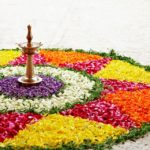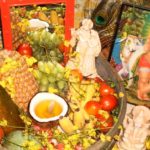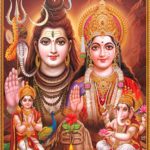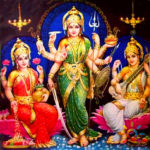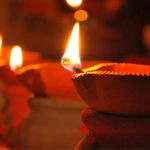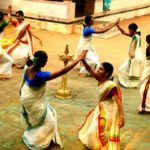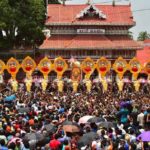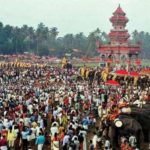KOODALMANICKAM UTSAVAM
The ancient and historic Koodalmanickam temple is situated in Irinjalakuda (70 kms from Cochin). The deity of this temple is Sree Bharatha who is generally not found consecrated in Kerala temples. This temple is in the true architectural pattern of Kerala temples. The festival here is held annually for all days in Medom (April-May). Kathakali, Ottamthullal, Panchavadayam and processions led by caparisoned elephants are the special features of the festival.
KODUNGALLOOR BHARANI UTSAVAM (50 kms from Cochin)
The Kodungallor Bhagavathi themple is one of the wealthiest temples in Kerala. Bhadrakali born of the third eye of Samhara Rudra, killed the demon Darika. It is to commemorate this event that the famous Bharani festival is celebrated in the Kodungalloor Bhagavathi temple in Meenam (March-April) every year. This festival attracts the largest congregation of Velichappadus (oracles) from all over Kerala.
MANNARASALA UTSAVAM
In olden time every Hindu family in Kerala has a serpent-grove. Mannarsala, situated to the north-west of Sri. Subramanyaswamy temple, Haripad, is the seat of the famous temple of Nagaraja (God of serpents), the largest of its kind in Kerala. Built in a grove the temple is reputed for having 30,000 images of snake-Gods.
On the day of Ayilliam asterism (September and October), all the serpent idols in the grove and the temple are taken in procession to the illam (family connected with the temple) where the offerings of Nurum Palum (rice flour and milk), kuruthi (a red liquid made of turmeric and lime) and cooked rice are made. The oldest female member of the family carries the idol of the Nagaraja and the procession is conducted with great pomp and rejoicing.
THYPPOOYA MAHOTSAVAM, Koorkancheri, Thrissur
This festival is dedicated to Subrahmanya, son of Siva. The highlight of Thypooya Mahotsavam is a spectacular Kavadiyattam, a ritual dance offering carrying kavadis (bow shaped wooden structures decorated with tapestry, flowers and peacock feathers) on the shoulders.
KORATTY MUTHY’S FEAST
About seven kilometers to the south of Chalakudy, there is an old catholic church built in honour of St. Mary which is locally known as “Koratty Muthy’s Church”. The most important festival in this church is the ‘Koratty Muthy’s festival celebrated during the second week of October every year. It is celebrated on the Sunday after the fifth of October and people from far and near flock to the place to give their offerings to their Beloved Mother. This festival has importance as a great annual fair of the locality.
MALAYATTUR FEAST
Malayattur is a village about six miles to the north-east of Kaladi, the birth place of the Hindu philosopher Sri Sankara. Situated on the banks of the Periyar and covered with thick hills, it is rightly called Malayattur. St. Thomas shrine at Malayattur is believed to be one of the ancient catholic shrines in the northern part of the State. The chief festival at the shrine is celebrated on the Sunday after Easter that is the second Sunday. The pilgrims have to climb a hill nearly 2000 feet high and on top of it is the church. The pilgrims chant prayers as they climb up and down the hill.
MANARCAD PERUNAL
St. Mary’s church at Manarcad, Kottayam is one of the outstanding churches of the Syrian Jacobite Church of Malabar. The most important festival here is the eight day fast in honour of St. Mary which starts on September 1. During all these days people belonging to all communities assemble here to make offerings and for fasting. On the 7th and 8th days colourful processions are taken out.
FESTIVAL AT CHERAMAN JUMAMASJID, Kodungalloor
This is the first Juma Masjid in India and is situated in the Methala Village of Kodungalloor taluk, hardly 20 kilometre from the Irinjalakuda railway station. According to the legend, Cheraman Perumal went on a pilgrimage to Arabia where he met Prophet Mohammed at Jeddah and embraced Islam and accepted the name Thajuddin. He married the sister of the then King of Jeddah and settled down there. Before his death he handed over the king of Jeddah several letters addressed to some rulers of Kerala seeking their help to propagate the tenets of Islam in Kerala. After his death the king came to Kerala and met the Rajah of Kodungalloor who helped him to convert the Arathali temple into a Juma Masjid. This mosque was designed and constructed by Hindus based on Hindu art and architecture. The graves of three great disciples are situated adjacent to this mosque which is the first in India and second in the world where the Juma prayers were started. People from all walks of life visit this mosque. Ramadan and Bakrid are the only celebrations held here.
FESTIVALS AT SABARIMALA
For many centuries Sabarimala has been an important pilgrim centre attracting devotees from all over India, especially from the Southern states. The presiding deity of Sabarimala is Lord Ayyappa known as Dhrama Sastha, his origin being traced to a union of Siva and Vishnu under special circumstance. He is also believed to have fulfilled his mission in life and rejoined his Supreme Self enshrined at Sabarimala. The temple is situated in the interior of the mountain ranges of the Western Ghats Sahyadri, and it is inaccessible except on foot. Pilgrims have to negotiate long shelter of the thick forests and tall mountains infested with all sorts of wild animals. Pilgrimage to Sabarimala cannot be undertaken at all seasons, because it requires long preparations and fixed timings. A devotee who wishes to perform the pilgrimage should undergo forty-one days’ Vritham (penance) consisting of strict celibacy, morning and evening ablutions, daily prayers. Saranamvilli or the call of dedication and refuge in Lord Ayyappa is an essential part of the daily worship. In Sabarimala, the devotees see the Makara Vilakku the appearance of the spontaneous phenomenon of strange light in the distance, indicating the presence of god, and return ennobled and strengthened in spirit. Situated not far from the Sabarimala temple, there is a shrine in the name of Vavar, a Muslim of great valour, who was thought to be a close associate to Sri. Ayyappa. It is a rare feature of the pilgrimage to Sabarimala that the Hindu pilgrims offer worship at this shrine of Vavar also during their trip, indicating the communal harmony that prevailed in Kerala for ages. During the entire pilgrimage, all distinctions of caste and class are forgotten.

